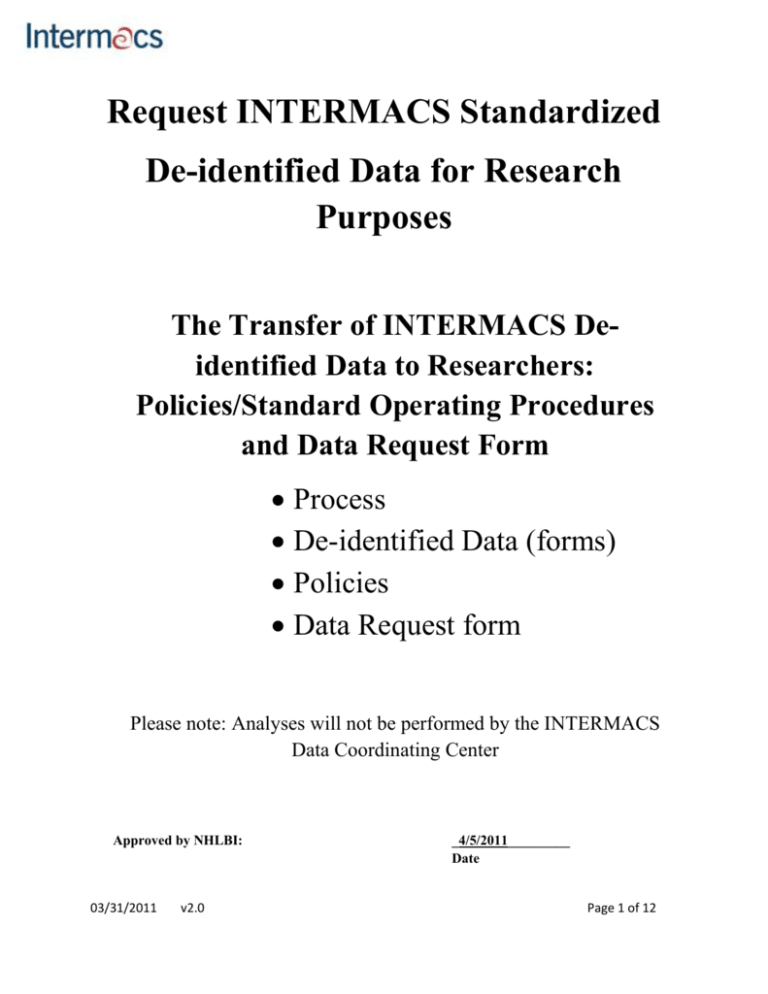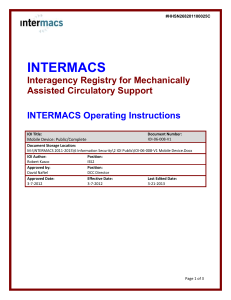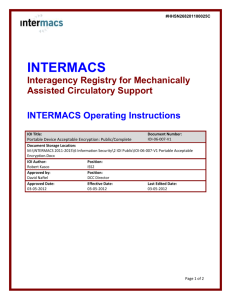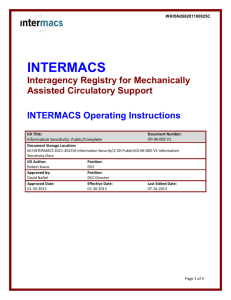Policies, Procedures and Request Forms
advertisement

Request INTERMACS Standardized De-identified Data for Research Purposes The Transfer of INTERMACS Deidentified Data to Researchers: Policies/Standard Operating Procedures and Data Request Form Process De-identified Data (forms) Policies Data Request form Please note: Analyses will not be performed by the INTERMACS Data Coordinating Center Approved by NHLBI: 03/31/2011 v2.0 _4/5/2011_________ Date Page 1 of 12 I. Introduction INTERMACS is a national resource for researchers in the area of mechanically assisted circulatory support devices. This document contains the policies and standard operating procedures for transferring INTERMACS patient level data to researchers. Researchers are defined as those individuals who are interested in conducting studies that advance one or more of the stated goals of INTERMACS (see table 1). For the purpose of this document, “researchers” do not include representatives from industry, federal agencies, commercial entities, insurance companies, other clinical databases, administrative databases and hospital consortia. Request for data from these entities should be directed to the INTERMACS DCC. The policies in this document follow the NIH policies for data sharing (http://grants.nih.gov/grants/policy/data_sharing/). II. Process A. Submit Request Attached to this document is a data request form for a researcher to request patient level data that is de-identified (see glossary). (This form is for requesting data and is not for requesting analyses or data summaries to be performed by the INTERMACS DCC.) This form will be submitted to the INTERMACS DCC. B. Review of the Request by the DAAP Committee The DAAP Committee will meet monthly to review and approve or disapprove the request. The DAAP Committee may ask the researcher for more specific details of the request. The general guidelines for review will be: 1. Does the request have scientific/clinical merit? 2. Is there sufficient data in INTERMACS to answer the research question? 3. Has the research question been recently addressed in an INTERMACS study or is one of the ongoing research projects in INTERMACS? 4. Does the researcher have the necessary resources (statistical and data management support) to conduct the research requested? If the research question submitted is similar for two or more requests then priority will be given to the researcher at an INTERMACS hospital. C. Notification to the Researcher The INTERMACS DCC will notify the researcher of the DAAP Committee’s decision. If the request is approved, then the researcher will be asked to submit a detailed statistical analysis plan (SAP – see glossary). D. Evaluation of the Statistical Analysis Plan (SAP) The INTERMACS DCC will review the statistical analysis plan (SAP) and will evaluate the plan according to its ability to provide the statistical analysis necessary to answer the research question. Statistical analysis plans that are deemed to be insufficient will be referred back to the researcher. We strongly recommend that the researcher collaborate with a statistician to create the statistical analysis plan (SAP). 03/31/2011 v2.0 Page 2 of 12 E. De-identified Data to the Researcher The INTERMACS DCC will transmit the de-identified data according to the information security protocol. The next section (III.) contains a description of the data that will be submitted. F. Data Management The researcher will be responsible for the data management of the de-identified data that he/she receives. Data management include linking of the datasets, file management, re-coding of variables for statistical analyses, sub-grouping of the data, calculation of derived variables, etc. A SAS programmer is required to manage this data. G. Statistical Analysis of the Data The researcher will conduct the statistical analyses of the data based on the statistical analysis plan (SAP). Again, we recommend that the researcher collaborate with a statistician to conduct the analyses. H. Results of the Analyses: abstracts, presentations, papers The researcher is to submit final abstracts, presentations and papers to the DAAP Committee (via the INTERMACS DCC) for final review. The INTERMACS DCC must have at least 4 weeks to review these materials before they are submitted to a journal or presented at a scientific meeting. If the DAAP Committee provides a favorable review then the INTERMACS DCC will notify the researcher. If the DAAP Committee provides an unfavorable review of the final abstract, presentation or paper, then the DAAP Committee will contact the researcher and DAAP Committee Chairman will serve as final arbiter of the identified issues. The researcher is to use the following sentence for acknowledgement of INTERMACS data: “The data for this study came from the Interagency Registry for Mechanically Assisted Circulatory Support (INTERMACS), National Heart Lung and Blood Institute, Contract number HHSN268200548198C, 2010” I. Time limitation on approval of a data request Once the researcher receives the data from INTERMACS, then the researcher has 1 year to complete the analyses and any resultant manuscript. At the end of 1 year of receipt of data the researcher should return the data to INTERMACS DCC and destroy any copies that may reside at the researcher’s location. If the researcher has not completed the research project within 1 year, then the researcher must submit a new data request go through the process stated above. III. De-Identified Data A. Form of the datasets: The INTERMACS web-based data entry system creates a complex series of relational databases. The DCC has linked and merged these databases into 4 research datasets. Patient dataset: 1 record per patient Patient demographics including race Patient outcomes including transplant, explant due to recovery, device exchange and death for each operation per patient Patient pre-implant information including hemodynamics, NYHA and INTERMACS patient profile level Device dataset: 1 record per implant operation Demographics including race 03/31/2011 v2.0 Page 3 of 12 Outcome including transplant, explant due to recovery, device exchange and death Pre-implant information including hemodynamics, NYHA and INTERMACS patient profile level Follow-up dataset: 1 record per follow-up visit per implant operation Includes pre-implant information for each implant operation Includes implant discharge information Events dataset: 1 record for each adverse event episode per implant operation Includes each rehospitalization per implant operation B. De-identification of data: All data that are sent to a researcher will be de-identified in 3 specific ways: Patient data: no patient identifiers will be included. This includes all PHI as defined by HIPAA. Therefore, the data will have no dates Hospital data: no hospital identifiers will be included. Device brand data: no device brand identifiers will be included. However, broad device descriptors such as pulsatile or continuous flow will be included. These 4 datasets will be SAS datasets. The major statistical packages (applications) have utility programs to translate a SAS dataset. C. Time Windows The INTERMACS data is adjudicated bi-annually and frozen datasets are produced after specific data cleaning processes have been implemented. The data time windows will be March 31st and September 30th of each year. The datasets will actually be ready for distribution 4 months after each data time window specified above. D. Data Acquisition and Quality Procedures These datasets will consist of data that have been collected according to the Manual of Operations (MOO) and will follow the protocol specified within the MOO. This includes a process for adjudication, completeness of data and data monitoring, IV. Required Policies for transferring and utilizing de-identified data requested by Researchers 1. INTERMACS will only consider 1 request at a time from a researcher. 2. The researcher has 1 year to complete their analyses based on this request. 3. The researcher may not attempt to merge INTERMACS data with any other database. 4. The researcher may not attempt to identify a patient within the datasets. 5. The researcher may not attempt to identify a hospital within the datasets. 6. The researcher may use the INTERMACS data for only the purpose stated in his/her request. 7. The researcher may not use the INTERMACS data for a public comparison of his/her institution’s data to the INTERMACS data. 8. The research may not disclose, print, copy or distribute the data he/she receives to any other entity. 03/31/2011 v2.0 Page 4 of 12 Table 1: 03/31/2011 v2.0 Page 5 of 12 Glossary Anonymized dataset - Previously identifiable data that have been de-identified and for which a code or other link no longer exists. An investigator would not be able to link anonymized information back to a specific individual. DAAP Committee – This is the INTERMACS Data Access, Analysis, and Publications Committee. Data Coordinating Center (DCC) – The DCC for INTERMACS is located in the Division of Cardiothoracic Surgery at the University of Alabama at Birmingham. A DCC provides support for large studies and focuses on central training in research methods, statistical leadership, data collection and management. Also known as a Coordinating Center or Biostatistical Center. Data Dictionary - A data dictionary, or metadata repository, as defined in the IBM Dictionary of Computing, is a "centralized repository of information about data such as meaning, relationships to other data, origin, usage, and format." The term may have one of several closely related meanings pertaining to databases and database management systems (DBMS): A document describing a database or collection of databases. Dataset - is a collection of data, usually presented in tabular form. Each column represents a particular variable. Each row corresponds to a given member of the data set in question. Its values for each of the variables, such as height and weight of an object or values of random numbers. Each value is known as a datum. The data set may comprise data for one or more members, corresponding to the number of rows. De-identified data - Under the HIPAA Privacy Rule, data are de-identified if either (1) an experienced expert determines that the risk that certain information could be used to identify an individual is "very small" and documents and justifies the determination, or (2) the data do not include any of the following eighteen identifiers (of the individual or his/her relatives, household members, or employers) which could be used alone or in combination with other information to identify the subject: names, geographic subdivisions smaller than a state (including zip code), all elements of dates except year (unless the subject is greater than 89 years old), telephone numbers, FAX numbers, email address, Social Security numbers, medical record numbers, health plan beneficiary numbers, account numbers, certificate/license numbers, vehicle identifiers including license plates, device identifiers and serial numbers, URLs, internet protocol addresses, biometric identifiers, full face photos and comparable images, and any unique identifying number, characteristic or code; note that even if these identifiers are removed, the Privacy Rule states that information will be considered identifiable if the covered entity knows that the identity of the person may still be determined. 03/31/2011 v2.0 Page 6 of 12 HIPAA elements - The following individually identifiable data elements, when combined with health information about that individual, make such information protected health information (PHI): Names All geographic subdivisions smaller than a State All elements of dates (except year) for dates directly related to an individual including birth date, admission date, discharge date, date of death Telephone numbers Fax numbers Electronic mail addresses Social security numbers Medical record numbers Health plan beneficiary numbers Account numbers Certificate/License numbers Vehicle identifiers and serial numbers, including license plate numbers Device identifiers and serial numbers Web Universal Resource Locators (URLs) Internet Protocol (IP) address numbers Biometric identifiers, including finger and voice prints Full face photographic images and any comparable images; and Any other unique identifying number, characteristic, code, or combination that allows identification of an individual. Limited access dataset – A limited access dataset is protected health information that excludes certain identifiers but permits the use and disclosure of more identifiers than in a de-identified dataset. In particular, the limited access dataset allows the inclusion of dates, 5 digit zip codes, and the city as indirect identifiers. Relational Database - A database that maintains a set of separate, related files (tables), but combines data elements from the files for queries and reports when required. The concept was developed in 1970 by Edgar Codd, whose objective was to accommodate a user's ad hoc request for selected data. Most every business database management system (DBMS), including Oracle, DB2, SQL Server, MySQL, etc., is a relational DBMS (RDBMS). SAS - A programmable integrated system of software published by SAS Institute Inc. for accessing, managing, analyzing, and reporting data. SAS Transport File - SAS XPORT transport format, also called Version 5 SAS transport format, is an open format published by the SAS Institute. The description of this SAS transport file format is in the public domain. Data can be translated to and from this SAS transport format to other commonly used formats without the use of programs from SAS Institute or any specific vendor. 03/31/2011 v2.0 Page 7 of 12 Statistical Analysis Plan (SAP) - a document that contains a more technical and detailed elaboration of the principal features of the analysis described in the protocol, and includes detailed procedures for executing the statistical analysis of the primary and secondary variables and other data. The components of a SAP include, but are not limited to, specific inclusion/exclusion criteria to define the patient cohort, specification of the primary and secondary endpoints, patient groups to be compared, statistical methods for group comparisons and methods to provide statistically adjusted comparisons, methods for time-related endpoints which includes a precise description of censoring mechanisms, methods for addressing missing data and a description of the expected power or necessary sample size for the primary statistical analyses. 03/31/2011 v2.0 Page 8 of 12 INTERMACS Data Request Form for Researchers Please fax the completed form to 205.975.0085 or Email completed form to Grant Studdard at gkst@uab.edu MOO v3.0 03/31/2011 Appendix Ja: DRFR Requestor (Name/Position)_________________________________ Date: __________ Requesting Hospital: ________________________________________ Contact information: email: _________________________ phone: _______________ Relationship to INTERMACS: [ ] Operations Committee member [ ] Clinical site Local PI [ ] Steering Committee member [ ] Clinical site - other: _____________________________ [ ] Subcommittee member [ ] Outside investigator [ ] Manufacturer representative company ___________________________________________________ Data Request for Researchers: Policy and Procedures Please read and sign and date this document in order to receive your data package requested. Your data package will contain the following information and will be transferred according to the following policy and procedures: I. II. Purpose of the Research Request: The de-identified data that I will receive will accomplish the following research (please attach your research purpose as follows): Specific Aims Background significance Study Design and Method Analytic Methods Anticipated findings Expected Dissemination of the Research Results (list organization / date) Abstract _____________________ / ________ Presentation _____________________ / ________ Publication _____________________ / ________ Internal Use _____________________ / ________ Other _____________________ / ________ 4 De-identified (SAS) datasets: these datasets will contain de-indentified INTERMACS Registry data within the specified time window listed in this SOP (see section III.C above) a. Patient dataset: 1 record per patient Patient demographics including race Patient outcomes including transplant, explant due to recovery, device exchange and death for each operation per patient Patient pre-implant information including hemodynamics, NYHA and INTERMACS patient profile level b. Device dataset: 1 record per implant operation Demographics including race Outcome including transplant, explant due to recovery, device exchange and death 03/31/2011 v2.0 Page 9 of 12 INTERMACS Data Request Form for Researchers III. IV. V. MOO v3.0 03/31/2011 Appendix Ja: DRFR Pre-implant information including hemodynamics, NYHA and INTERMACS patient profile level c. Follow-up dataset: 1 record per follow-up visit per implant operation Includes pre-implant information for each implant operation Includes implant discharge information d. Events dataset: 1 record for each adverse event episode per implant operation Includes each rehospitalization per implant operation You will also be provided with a SAS transport file containing all 4 de-identified listed above. This SAS transport file will facilitate the importing of your SAS datasets onto any SAS platform that you are running at your organization (i.e. PC, UNIX, etc). Data Dictionaries: You will receive a data dictionary for each of the de-identified described above. These data dictionaries will provide a technical data management tool for your data manager. All data elements within these 4 datasets will be described according to its SAS specifications. This data management tool will allow your data manager to do all work necessary to fully manage and analyze this INTERMACS data. Data Transfer: You will receive the above listed files (#I and #II) via a secure data transfer system (UAB DropBox). This system will require a single point of contact to receive the data and instructions will be given to your point of contact to download your data and additional documentation. The SAS datasets and SAS Transport file will be password protected for security according to INTERMACS protocol. Your point of contact to receive the data will be required to call Grant Studdard at (205-934-1193) to obtain this password and to complete your download and access to your data. Data Consultation: Once we have completed the data transfer listed above you will then be responsible for all data management and analyses with your requested INTERMACS data. If you require any support with data management or statistical analyses consultation with the INTERMACS DCC can provide this support for an additional charge per hour (up to a total of 10 hours max) which will be invoiced to your organization. There is no charge for receiving the de-identified datasets. Agreements required to process this request In order to process this request you must sign all agreements below and fax to the number listed or provide an electronic signature and email to the email address listed above. Data Request Researchers: Policies and Procedures Agreement I have read, understand and agree to the entire above policy “The Transfer of INTERMACS De-identified Data to Researchers: Policies and Standard Operating Procedures” . I will also adhere to the NIH data sharing policies listed at http://grants2.nih.gov/grants/policy/data_sharing ____________________________________ Signature ________________________ date Confidentiality Agreement I agree to use the data that I receive based on this request only for the purposes explicitly stated in this request. I also agree not to disclose, print, copy or distribute the data that I receive based on this request without appropriate permission from the INTERMACS DCC. ____________________________________ Signature 03/31/2011 v2.0 ________________________ date Page 10 of 12 Statistical Support The following personnel will provide statistical support for this research project. ____________________________________ Signature ________________________ date ____________________________________ Email address ________________________ work phone number Data Management Support The following personnel will provide data management support (SAS) for this research project. ____________________________________ Signature ________________________ date ____________________________________ Email address ________________________ work phone number Current Conflict of Interest disclosure form: 03/31/2011 v2.0 Included ( ) on file at DCC ( ) Page 11 of 12 03/31/2011 v2.0 Page 12 of 12









